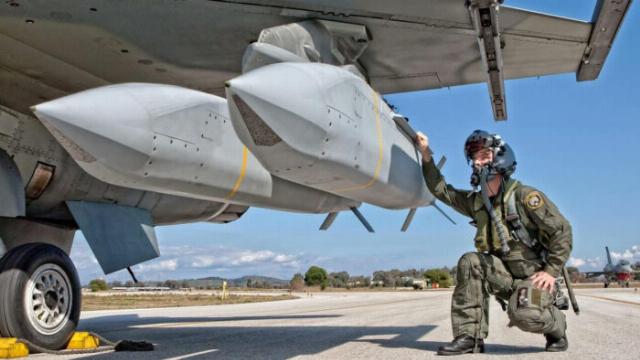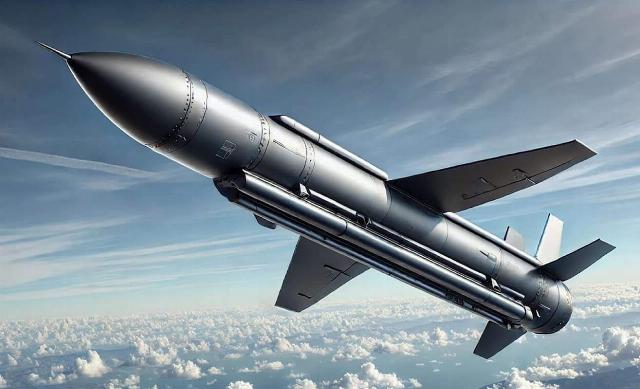According to officials in the US Air Force, Ukraine is likely to become the recipient of a new relatively inexpensive high-precision air-based munition. Its development under the name "Extended Range Attack Munition" (ERAM) is planned to begin in the near future.
It is believed that the promising product, whose range can reach 250 miles (more than 400 km), will provide the Ukrainian Air Force with new opportunities to strike targets beyond the reach of many types of weapons currently available in the arsenal of the Armed Forces of Ukraine, including precision-guided bombs supplied by the West. It also provides an ideal opportunity to conduct a more direct assessment in real conditions of developing concepts for the rapid development and expansion of production of relatively complex weapons systems. The search for ways to rapidly increase the retaliatory strike capability and significantly increase the corresponding reserves is of particular interest to the US Armed Forces , especially in light of planning for a potential future high-level conflict with China.
On July 10, 2024, the Weapons Department of the United States Air Force Aircraft and Equipment Lifecycle Management Center (AFLCMC/EB) published another request for Proposals (RFP) regarding ERAM. According to a statement from the Air Force, it is intended to provide the initial stages of the creation of a new air-based strike munition marked ERAM, which "is crucial to accelerate Ukraine's ability to effectively and efficiently meet the needs of military fighters and will provide affordable mass weapons that will be produced on a large scale." "The government is committed to prototyping and adapting a commercial autonomous modular open architecture delivery vehicle that can provide affordable long-range impact. The resulting prototype will provide a platform suitable for mass production."
The U.S. Air Force issued its first government contract notice regarding ERAM in January 2024. However, at that time there was no mention of any connection with Ukraine. The new assignment already talks about providing complete data from each of the 16 companies that responded to the previous request for proposals (moreover, none of these companies are named).
The request for proposals refers to a set of requirements for ERAM, which, meanwhile, have not been made public. Sources, with reference to the January appeal, indicate the following key parameters:
- A 500 lb (226 kg) impact munition with a range of at least 250 miles and a maximum speed of at least Mach 0.6 is required. The mass of the warhead was not specified, but it must be of a high-explosive/fragmentation type with at least some degree of penetration and unspecified variable fuse settings;
- The ERAM internal navigation system should "work in conditions of deteriorating GPS quality";
- a circular probable deviation of no more than 10 m, at least in 50% of cases, "both in the absence of electromagnetic interference and in conditions of high electromagnetic interference (including deterioration of GPS quality)."
Additionally, the customer also demanded a design that would allow the manufacturer to produce 1000 units. for two years, or an average of almost 42 units per month.
Experts note that previously the US Armed Forces had their own interest in precision-guided munitions suitable for use in conditions of intensive counteraction of electronic warfare, but these specific requirements now make even more sense, given that ERAM is intended for Ukraine. It is reported that the Russian Armed Forces use electronic warfare systems that effectively combat GPS guidance complexes installed on various air and ground-based munitions that the Armed Forces received from the United States and other Western partners. It is emphasized that, in general, the requirements for ERAM meet the requirements for derivatives of JDAM or PJDAM offered by Boeing, as well as for the version of the Joint Stand-Off Weapon (JSOW) planning bomb from Raytheon.

JSOW Family Planning Bombs
It is assumed that the ERAM strike munition will provide Ukrainian pilots with an additional valuable opportunity to hit targets deeper behind the front line, as well as reduce their vulnerability to a very real threat from Russian air defense systems, which Ukraine is also actively hunting. Depending on the propulsion system of the ammunition and the flight profile, Ukrainian Air Force aircraft would be able to hit enemy forces at considerable distances, even firing weapons at lower altitudes.
In addition to the specific characteristics of the combat use of ERAM, the possibilities of increasing its production are equally important. Today, the Ukrainian Air Force has a clear need for more ammunition, and sustainable supply chains are crucial for continued operations.
In this regard, it is noted that not only the US Air Force, but also other services may be interested in this weapon. Interestingly, the first original request for ERAM was issued around the same time that the US Navy conducted similar actions with respect to the munition, dubbed Multi-purpose effector of available power (Multi-Mission Affordable Capacity Effector, MACE). In June, the Defense Innovation Division of the U.S. Department of Defense (DIU), in collaboration with AFLCMC/EB, also announced that it had selected four companies to prototype a relatively inexpensive and easy-to-manufacture test vehicle (ETV). The Air Force has stated that it is particularly interested in the ETV project as a stepping stone to future cruise missile concepts. Obviously, these efforts reflect initiatives aimed at reducing costs and accelerating the large-scale production of a variety of systems, especially in unmanned versions.
According to experts, the US Armed Forces expect to use up a large amount of ammunition already at the initial stages of any future high-level conflict, especially against China in the vast expanses of the Pacific Ocean. Cheaper and easier-to-manufacture designs will be crucial to build up the appropriate capacity now and replenish stocks during a prolonged conflict in more cost-effective ways. The ongoing operations in response to the Yemeni Houthi campaign in and around the Red Sea, as well as the contribution of the US Armed Forces to protecting Israel from missiles and UAVs supplied from Iran, have shed new light on the expenditure of ammunition and resupply.
Given all this, it is believed that the ERAM impact munition will make it possible to go through the entire cycle of rapid prototyping and deployment of a weapon system, which will then be directly used in a real conflict. Whatever the results, the lessons learned will be extremely valuable to all parties involved. The conflict in Ukraine is already being used as a real testing ground for weapons and other materiel.
Providing information that the US Air Force is developing ERAM for its Ukrainian counterparts has serious consequences, since the creation of this weapon can have broader consequences, especially when it comes to ways of its development and production, which go far beyond the Ukrainian conflict.
Based on the materials of the resource twz.com

